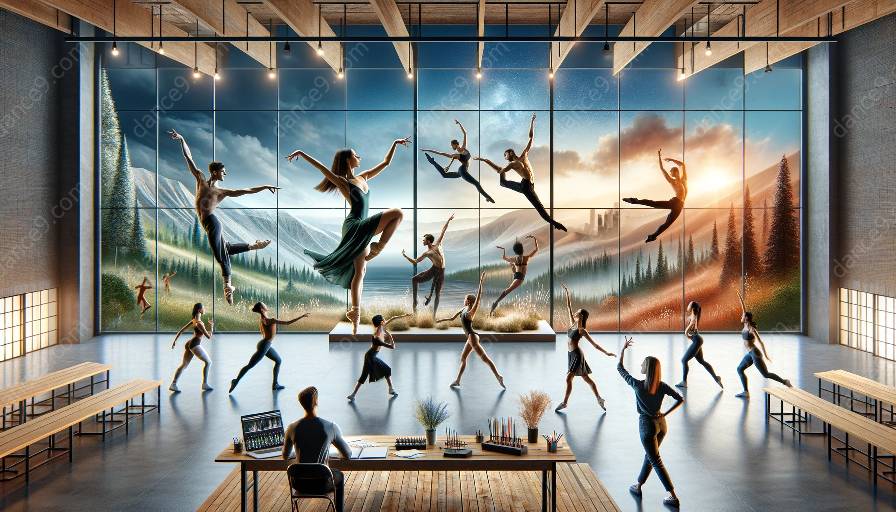Group choreography is a captivating dance discipline that involves creating harmonious, synchronized movements and patterns with multiple performers. In this topic cluster, we will delve into the intricacies of group choreography dynamics and techniques, exploring how to incorporate the fundamental principles of choreography to elevate dance performances to new heights.
Understanding Group Choreography
Group choreography involves designing movements and sequences that engage and showcase the collective talent of dancers. It requires a deep understanding of spatial awareness, timing, and coordination to create visually captivating and emotionally engaging performances. Group choreography dynamics and techniques encompass various elements that contribute to the seamless integration of multiple dancers into a cohesive ensemble.
Key Elements of Group Choreography Dynamics
Several key elements define the dynamics of group choreography:
- Formation: The arrangement and positioning of dancers within the performance space play a crucial role in creating visually compelling choreography. Choreographers must consider the interplay of different formations, transitions between formations, and the overall spatial dynamics of the dance piece.
- Interactions: Group choreography often involves intricate interactions between performers, such as mirroring movements, partnering, and collaborative sequences. These interactions add depth and complexity to the choreography, requiring precise execution and seamless coordination among the dancers.
- Levels and Elevation: Group choreography can incorporate diverse levels and elevation, including floor work, standing movements, jumps, and lifts. Managing these varying levels effectively contributes to the visual dynamics and aesthetic appeal of the performance.
- Rhythmic Patterns: Choreographers utilize rhythmic patterns to synchronize movements across the group, creating rhythmic motifs and patterns that enhance the musicality and dynamics of the choreography.
- Energy Dynamics: Understanding the ebb and flow of energy within the group choreography is essential for creating dynamic contrasts and engaging transitions. Choreographers strategically manipulate energy dynamics to convey emotional nuances and dramatic impact.
Techniques for Effective Group Choreography
To achieve cohesive and captivating group choreography, dancers and choreographers employ a range of techniques that align with the principles of choreography:
- Collaborative Composition: Engaging dancers in the creative process fosters a sense of ownership and commitment to the choreography. Collaborative composition techniques encourage dancers to contribute movements, ideas, and expressions, leading to a more authentic and integrated performance.
- Transitions and Flow: Smooth transitions between movements and formations are critical for maintaining the fluidity and continuity of group choreography. Effective transitions enhance the overall aesthetic quality and coherence of the dance piece.
- Emotional Connection: Group choreography relies on the ability of dancers to convey emotional depth and connection with one another. Techniques such as eye contact, shared dynamics, and synchronized expressions contribute to the emotional resonance of the performance.
- Visual Centering and Focal Points: Utilizing visual centering and focal points within the choreography directs the audience's attention and enhances the overall visual impact. Strategic placement and manipulation of focal points create captivating visual dynamics within the performance space.
- Musical Interpretation: Understanding and interpreting the nuances of music is integral to creating choreography that resonates with the auditory elements. Choreographers explore musical phrasing, accents, and dynamics to craft movements that harmonize with the musical composition.
Principles of Choreography in Group Context
Integrating the principles of choreography into group dance performances enriches the artistic and technical aspects of the choreographic process. The following principles are foundational to creating impactful group choreography:
- Unity and Diversity: Group choreography seeks a balance between unity and diversity, blending the individual qualities of dancers while presenting a cohesive and harmonious ensemble. Choreographers explore ways to celebrate individuality within the context of collective expression.
- Composition and Arrangement: Effective group choreography relies on thoughtful composition and arrangement of movements, shapes, and spatial relationships. Choreographers employ techniques such as motif development, spatial patterning, and dynamic contrasts to create engaging compositions.
- Expressive Dynamics: Embracing expressive dynamics allows dancers to embody a range of qualities, from softness and fluidity to strength and dynamism. Choreographers guide dancers in conveying emotional nuances and kinetic dynamics to deepen the expressive impact of the choreography.
- Rhythmic and Spatial Awareness: Mastering rhythmic and spatial awareness is essential for achieving synchronization and precision within group choreography. Dancers develop an acute sense of timing, phrasing, and spatial relationships to enhance the cohesiveness and dynamic richness of the performance.
- Narrative and Conceptual Depth: Group choreography can encompass narrative elements and conceptual depth, conveying themes, stories, or abstract concepts through movement. Choreographers infuse choreography with depth and meaning, engaging audiences on intellectual and emotional levels.
Exploring Choreography's Impact on Dance Performance
Choreography serves as the creative foundation and artistic vision that shapes dance performance. When applied to group choreography, the principles and dynamics of choreography contribute to captivating and memorable dance experiences.
Engaging Audiences:
Well-crafted group choreography captivates audiences, drawing them into the collective artistry and synchronized beauty of the performance. The principles of choreography guide dancers and choreographers in crafting movements that resonate with viewers on emotional, intellectual, and visual levels.
Enhancing Artistic Expression:
Group choreography provides a platform for dancers to express individuality within the context of cohesive, unified ensembles. The principles of choreography infuse group performances with artistic depth, allowing dancers to convey compelling narratives, themes, and emotions through synchronized movement.
Creating Memorable Experiences:
Effective use of choreographic dynamics and techniques elevates group dance performances, leaving a lasting impression on audiences. The integration of choreography principles enhances the memorability and impact of choreographed group pieces, showcasing the collective talent and skill of the performers.
By understanding and applying the intricate dynamics and techniques of group choreography, while staying true to the principles of choreography, dancers and choreographers can create awe-inspiring and harmonious dance performances that resonate with audiences and leave a lasting artistic imprint.






































